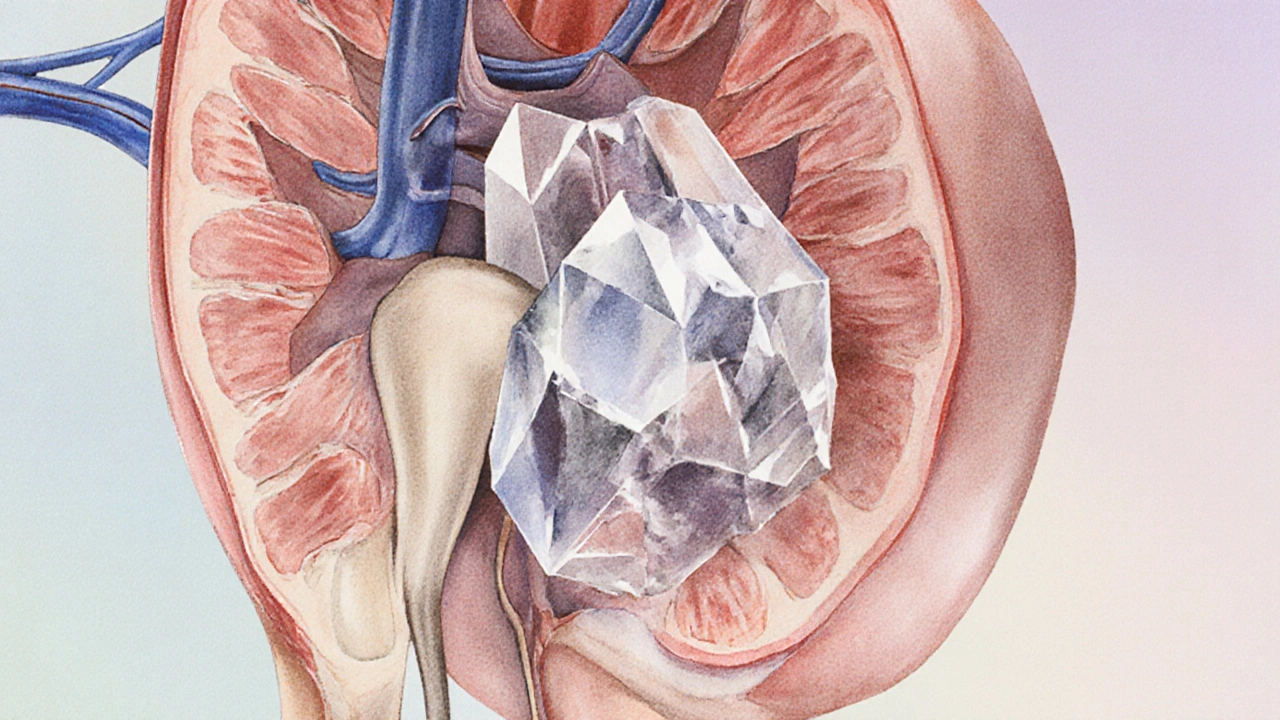Kidney stones are hard mineral deposits that form inside the renal system. They travel through the ureter and often trigger what doctors call renal colic, a sudden, excruciating pain that can mimic severe stomach pain.
When Stomach Pain Isn’t a Stomach Problem
Many people think a stabbing sensation in the upper abdomen automatically means a gut issue-gas, ulcer, or gallbladder trouble. However, the kidneys sit just behind the lower ribs, and a stone moving down the ureter can radiate pain upward, making you feel it in the belly or even the chest. This overlap is why emergency rooms often see patients with "stomach pain" who end up diagnosed with kidney stones after imaging.
How the Urinary Tract Sends Pain Signals
Ureter is the thin muscular tube that carries urine from the kidney to the bladder. When a stone blocks the ureter, the muscle contracts violently in an effort to push the stone out, creating pressure that triggers nerves shared with the abdomen.
This shared nerve pathway, called the visceral-somatic overlap, explains why pain can be felt in the flank, lower back, groin, or upper abdomen. The intensity often spikes every few minutes as the stone shifts, a pattern known as "colicky" pain.
Types of Kidney Stones and Their Pain Profiles
Calcium oxalate stones are the most common, making up about 70% of cases. They tend to form in acidic urine and cause sharp, intermittent pain.
Uric acid stones develop in persistently low‑pH urine, often in people with gout or high‑protein diets. Their pain may linger longer because they dissolve more slowly.
Other types-struvite stones (linked to infections) and cystine stones (genetic)-have distinct patterns but all trigger the same ureteral spasm.
| Stone Type | Typical Composition | Usual Urine pH | Common Cause | Prevention Tip |
|---|---|---|---|---|
| Calcium Oxalate | Calcium + Oxalate | 5.5-6.5 (acidic) | High oxalate foods, low fluid intake | Drink >2L water daily, limit spinach, nuts |
| Uric Acid | Uric Acid Crystals | <6.0 (very acidic) | Gout, high‑purine diet | Alkaline diet, limit meat, increase citrus |
| Struvite | Magnesium‑Ammonium‑Phosphate | 7.0-7.5 (neutral to alkaline) | Recurrent urinary tract infections | Prompt treatment of UTIs, adequate hydration |
| Cystine | Cystine Crystals | 6.0-6.5 (moderately acidic) | Genetic disorder (cystinuria) | High fluid intake, thiol‑binding meds |
Diagnostic Tools: CT Scan vs. Ultrasound
CT scan is the gold‑standard imaging method for suspected kidney stones. It detects stones as small as 1mm, shows exact location, and differentiates them from other abdominal issues.
When radiation exposure is a concern-pregnant patients or children-ultrasound offers a safe alternative. Though slightly less sensitive, it can reveal hydronephrosis (swelling of the kidney) that signals a blockage.
Both modalities often include a simple urine analysis to check for blood, crystals, or infection, which helps decide the stone’s composition before treatment.

Distinguishing Renal Colic from Gastrointestinal Pain
- Location: Renal colic typically starts in the flank and migrates toward the groin; GI pain stays more central.
- Pattern: Colicky pain comes in waves every 2-5minutes, while gut pain is usually constant.
- Associated signs: Hematuria (blood in urine) is a hallmark of stones; nausea/vomiting can appear in both but is more frequent with renal colic.
- Response to medication: NSAIDs (e.g., ibuprofen) often relieve stone pain quickly; antacids do not.
When in doubt, medical evaluation is essential. A missed stone can lead to kidney damage, while an unnecessary urologic workup can delay proper GI treatment.
Emergency Care and Pain Management
In the ER, doctors usually start with IV fluids to encourage stone passage. NSAIDs (like ibuprofen or ketorolac) are first‑line for pain because they reduce ureteral spasm.
If NSAIDs are contraindicated, opioids may be used short‑term, but they don’t address the underlying cause.
For stones larger than 5mm, urologists consider extracorporeal shock wave lithotripsy (ESWL), a non‑invasive method that breaks the stone into passable fragments. If the stone is stuck near the bladder, a ureteroscopic laser procedure may be chosen.
Prevention: Lifestyle and Metabolic Work‑up
After the acute episode, preventing recurrence is key. The most effective steps include:
- Hydration: Aim for at least 2-3L of urine output daily (roughly 8-10 cups of water).
- Dietary tweaks: Limit high‑oxalate foods (spinach, nuts), moderate animal protein, and add citrus fruits to raise urinary citrate.
- Check metabolic factors: A 24‑hour urine test can reveal excess calcium, oxalate, uric acid, or low citrate, guiding targeted medication (e.g., thiazides for calcium, allopurinol for uric acid).
- Address infections: Prompt treatment of urinary tract infections reduces struvite stone risk.
- Medical therapy: In recurring cases, doctors may prescribe potassium citrate, thiazide diuretics, or citrate supplements based on stone type.
Related Topics and Next Steps
This article sits within a broader health cluster that includes "Understanding Kidney Function," "Managing Chronic Back Pain," and "When to Seek Emergency Care for Abdominal Pain." Readers interested in the metabolic side may explore "24‑Hour Urine Testing Explained" or "Diet Plans to Prevent Calcium Oxalate Stones." Those focused on immediate relief can jump to "Quick Home Remedies for Renal Colic".

Frequently Asked Questions
Can severe stomach pain be the only symptom of a kidney stone?
Yes. While flank pain is classic, a stone may cause pain that radiates to the upper abdomen, mimicking gastrointestinal issues. Hematuria, nausea, and a history of stones increase the suspicion.
How fast does a kidney stone pass?
Stones smaller than 4mm often pass within a few days to two weeks with adequate hydration. Larger stones may take weeks or require medical intervention.
Is a CT scan always necessary?
CT without contrast is the most accurate test, but ultrasound is acceptable for pregnant patients, children, or those avoiding radiation. The choice depends on clinical urgency and patient factors.
What home measures can ease the pain?
Drink plenty of water, take NSAIDs as directed, apply a heating pad to the flank, and try gentle movement (walking) to help the stone move down.
Can diet alone prevent all kidney stones?
Diet plays a major role, especially for calcium oxalate and uric acid stones, but genetics and metabolic disorders also contribute. A comprehensive approach-including fluid intake, diet, and sometimes medication-offers the best protection.

The alleged kidney‑stone epidemic is merely a pharma‑driven scare tactic.
While I appreciate your skepticism, the medical literature does show clear evidence linking ureteral colic to stone passages. The pain pathways are well‑documented, and imaging often confirms the diagnosis. It's not just a marketing ploy; many patients find relief after appropriate treatment. Staying informed helps us separate hype from genuine health concerns. Remember, hydration and diet can make a big difference.
Kidney stones can indeed masquerade as severe abdominal pain because of the visceral‑somatic overlap you described. When the ureter contracts, the pain radiates to the flank, lower back, or even the upper abdomen. Early detection via ultrasound or CT scan is crucial to prevent complications. Increasing water intake and moderating oxalate‑rich foods are practical preventive steps.
Great, another reminder to drink water-like I haven’t heard that a million times. Maybe the real trick is to stop eating pizza and call it a day.
It's worth noting that not all stones cause the same intensity of pain; size and composition play big roles. Smaller calcium oxalate crystals often pass with minimal discomfort, whereas larger uric acid stones can create prolonged colicky episodes. Patients should discuss stone analysis with their urologist to tailor prevention strategies.
Indeed, the biochemical ballet within our kidneys is a marvel-each ion dancing to a pH‑driven symphony. When that harmony is disrupted, the consequences can be excruciating, reminding us of the delicate equilibrium we so often take for granted.
One must appreciate the nuanced pathophysiology underpinning nephrolithiasis, for it is not merely a trivial inconvenience but a testament to the intricate interplay of metabolic, dietary, and genetic factors that converge upon the renal milieu. The prevalence of calcium oxalate stones, comprising approximately seventy percent of cases, underscores the ubiquity of dietary oxalates and the pivotal role of adequate hydration in mitigating supersaturation. Moreover, the less common uric acid stones, often associated with hyperuricemia and low urine pH, necessitate a tailored approach involving alkalinization of the urine alongside lifestyle modifications. While the literature abounds with clinical guidelines, the practical translation into patient‑centered care demands both empathy and precision. In the emergency setting, swift imaging-typically a non‑contrast CT-provides definitive diagnosis, yet the subsequent management hinges upon stone size, location, and symptom severity. For stones less than five millimeters, conservative management with analgesics and alpha‑blockers may suffice, whereas larger obstructions might require lithotripsy or ureteroscopy. Ultimately, the interdisciplinary collaboration between primary care physicians, urologists, and nutritionists forms the cornerstone of effective prevention and treatment. Thus, the broader medical community must continue to disseminate evidence‑based strategies while remaining vigilant to the evolving epidemiology of renal calculi.
While your exposition is undeniably erudite, it borders on pedantry, obscuring the pragmatic steps patients can actually implement. Simpler guidance-such as “drink eight glasses a day” and “limit high‑oxalate foods”-would serve the majority far better than verbose dissertations.
I think it's helpful to balance detailed medical explanations with actionable advice. Everyone benefits from clear recommendations about fluid intake, diet, and when to seek medical attention.
Indeed, the pursuit of health is a dialectic between knowledge and habit; only through mindful integration can we translate theory into sustainable practice.
Just a heads‑up: sometimes what feels like a stomach ache could be that sneaky stone making its way down. The colicky pattern-sharp spikes every few minutes-is a tell‑tale sign. If you notice blood in the urine or persistent nausea, it’s worth getting scanned. Early detection can save you from a painful ER visit.
Good point. I’d add that staying attentive to urine color can be an early indicator; pale yellow usually means good hydration.
From a clinical perspective, a thorough patient history coupled with targeted imaging remains the gold standard for distinguishing renal colic from gastrointestinal etiologies. Specific questions regarding prior stone episodes, dietary habits, and family history can guide diagnostic pathways. Moreover, laboratory evaluation-including serum calcium, uric acid, and urine pH-provides valuable ancillary data. Prompt identification facilitates appropriate therapeutic decisions, potentially averting complications such as obstruction or infection.
Absolutely love this! 🎉 Keep those kidneys happy-drink water, watch those oxalates, and stay active! 💪
In addition to the preventive measures already mentioned, patients with recurrent stones may benefit from metabolic evaluation to identify underlying abnormalities. Tailored pharmacologic therapy, such as thiazide diuretics for calcium stones or allopurinol for uric acid stones, can be effective when combined with lifestyle changes.
Sure, but remember that not all doctors are looking out for you-some might push meds just to make money.
This info is useless fluff.
Even if some details seem overstated, the core message about hydration and diet is solid and worth following.
Kidney stones are a common medical condition that many people underestimate.
Kidney stones are a common medical condition that many people underestimate.
The pain they cause can mimic other abdominal issues making diagnosis tricky.
Understanding the anatomy of the urinary tract helps explain why the pain radiates.
The ureter’s muscular wall contracts forcefully when a stone blocks its path.
This contraction generates the sharp colicky pain described in the article.
Different stone compositions such as calcium oxalate or uric acid have distinct formation pathways.
Dietary choices play a major role in influencing urine pH and mineral concentration.
Drinking enough water dilutes the urine and reduces the chance of crystal aggregation.
Patients with a family history of stones should consider regular screening.
Imaging techniques like non‑contrast CT provide quick and accurate identification.
Small stones often pass spontaneously with supportive care and pain management.
Larger stones may require interventions such as lithotripsy or endoscopic removal.
Preventive strategies include limiting high‑oxalate foods and moderating protein intake.
Consultation with a urologist can tailor a plan based on stone analysis results.
Staying informed and proactive can greatly lower the risk of future episodes.